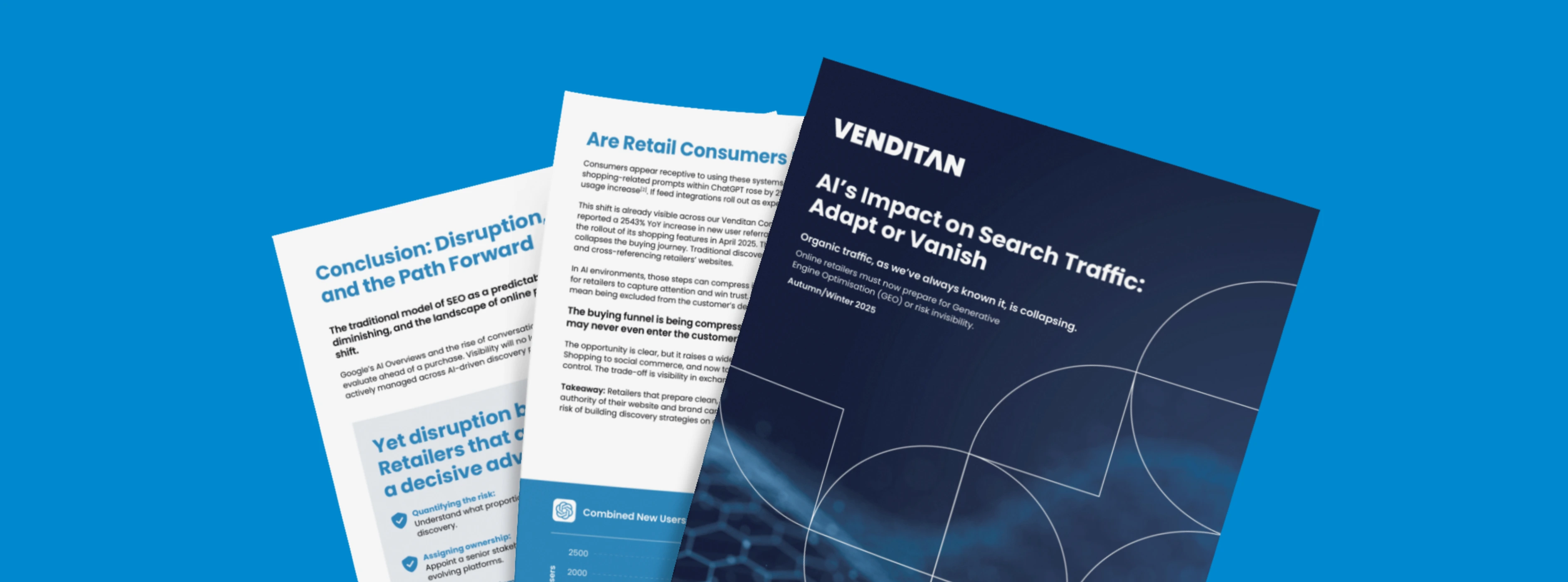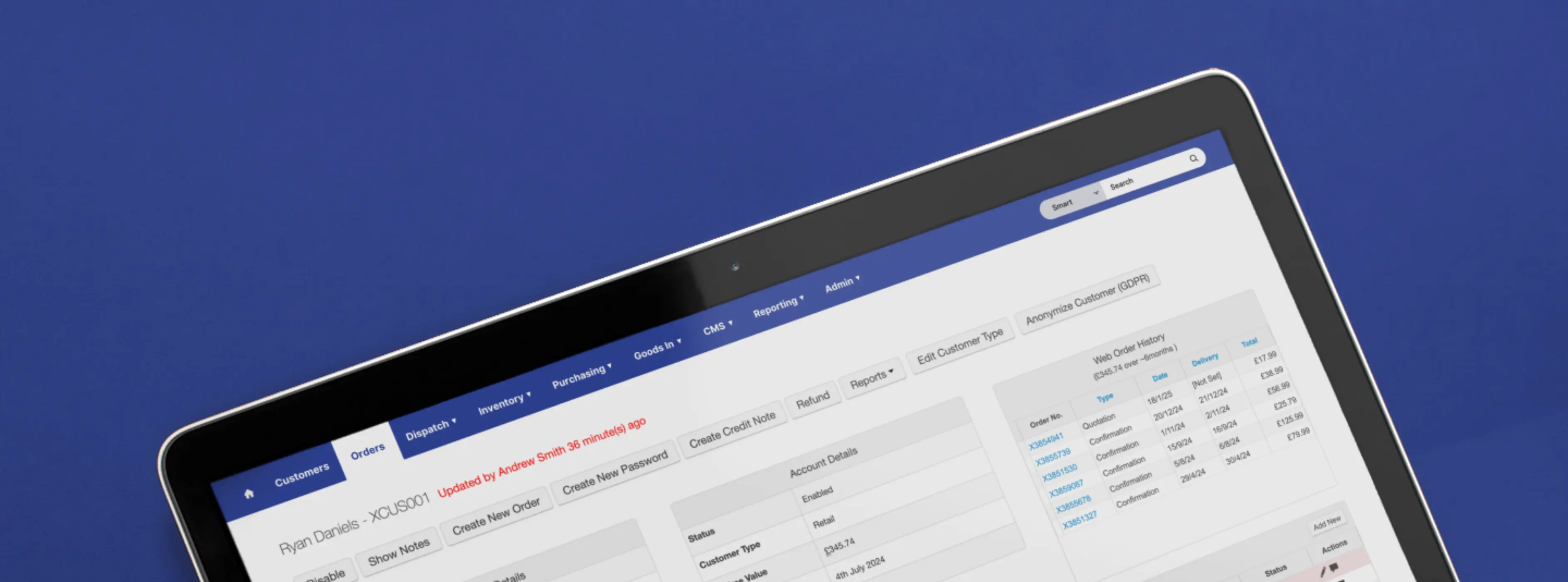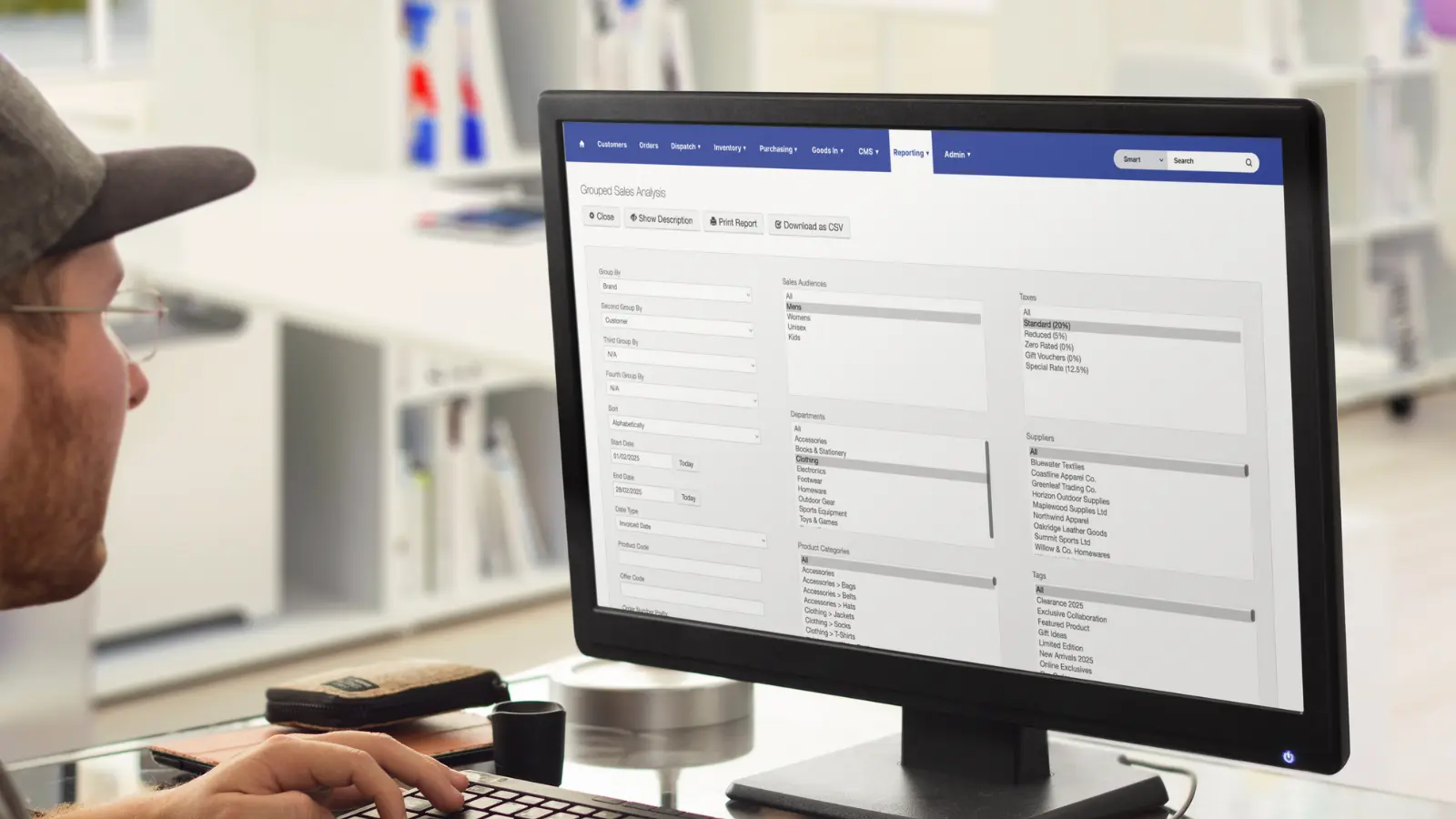Brands with outstanding customer experience generate 5.7x more revenue than competitors who fall behind.
This statistic highlights the crucial impact of customer satisfaction on your business's bottom line.
This article discusses the current eCommerce pain points, putting them on your radar so you can navigate them effectively, retain more customers and drive revenue growth.
Fragmented sales channels
“The customer retention rate of companies with a strong omnichannel approach is around 89%, while companies with a weak omnichannel approach see a retention rate of just 33%.”
Inconsistencies in pricing, availability, product information, and general service across your sales channels can be a major source of pain. Customers expect a seamless shopping experience regardless of where they shop with you.
Imagine you're shopping online for some jeans. You find a pair that you like, they’re discounted to £34.99, and available for collection in-store. When you arrive at the store, you find the product labeled at the full retail price of £49.99, or worse yet, it’s not available in the size that was listed online.
This lack of synergy between online and offline experiences is one of many ways that poor omnichannel delivery can lead to customer frustration.
How to get the experience right
Aligning your pricing, inventory, and service standards will provide a smooth and cohesive shopping experience. When customers know they can rely on your brand for consistency, they are more likely to return and recommend your business to others.
Real-time inventory management
Invest in technology that gives you a real-time view of inventory across any location that you hold stock, whether that be a store or a warehouse. Automatic updates of inventory movement can help stop overselling and provide a true representation of stock availability to your customers.
Omnichannel order capture
Implement a system where all orders, regardless of the sales channel, feed into one unified point of control. This means customers can shop with you online, in-store, or through any other channel, and their orders will be seamlessly reflected in their accounts.
Centralised product information management
Use a centralised PIM system to maintain consistent product data across all sales channels. This ensures uniformity in information, pricing, offers and availability, providing customers with a cohesive and trustworthy shopping experience.
Inadequate search and merchandising
“69% of consumers go directly to the search bar when visiting an online retailer, but 80% of those surveyed admitted to leaving because they were dissatisfied with the on-site search experience.”
I recently visited a well-known outdoor shopping outlet and spent 10 minutes trying to find an item before finally accepting defeat and asking an assistant for help.
The problem is that eCommerce websites don't have assistants on hand.
Whether it's through search, merchandising, filtering, or the navigation system, all these elements play a crucial role in reducing friction and helping customers find the right product or category with minimal clicks.
If customers can't quickly navigate to the products they're looking for or find the information they need to make a purchase decision, they'll likely leave your site altogether.
How to get the experience right
Taking stock of the browsing experience your website provides may uncover some low-hanging fruit that you can quickly address to help your customers find their product quickly.
Invest in your search functionality
In 2024 there are an abundance of advanced search capabilities to make finding products easy and intuitive. Consider filterable or faceted search results, predictive search, auto-complete suggestions, and personalised search results based on user behaviour, all of which can enhance your search bar and make it worth using.
Merchandise your products
Use visual callouts on product listing pages (PLPs) and product detail pages (PDPs) to highlight key information. This can include related offers, unique selling points (USPs), available colours, and other important details. Effective merchandising helps customers quickly identify the products that meet their needs, reducing the time and effort required to make a purchase.
Tidy up your filter system
Ensure your filter system is well-organised and relevant. Over time, product tags and attributes can become messy, leading to a cluttered and confusing filter experience. Regularly review and update your filters to keep them accurate and useful.
No reward for customer loyalty
“54% of customers may stop shopping with a business they feel isn't engaging with them enough.”
Loyal customers are the backbone of any successful business; they spend more, refer friends, and are more likely to forgive occasional hiccups.
When these valuable customers feel unappreciated, they may question their allegiance to your brand.
Without loyalty rewards, customers may perceive that their continued patronage is taken for granted. This can lead to feelings of neglect and prompt them to explore competitors who offer more tangible benefits for their loyalty.
How to get the experience right
We're living in the age of the Tesco Clubcard, where personalised rewards and loyalty programs have become the norm.
Customers now expect tailored incentives and recognition for their continued patronage, making loyalty programs essential for retaining and engaging them.
Start with a customer questionnaire
Starting with a customer questionnaire can provide invaluable insights into what types of loyalty scheme and offers will resonate most with your audience. By directly asking customers about their preferences, you can tailor your rewards to meet their specific desires and needs.
Launch your own loyalty offering
Launch your own loyalty offering by exploring various methods that suit your business model. If you offer high-ticket items, particularly in B2B eCommerce, you might prefer a direct approach over a traditional scheme. This doesn't mean you can't reward your customers; consider personalised discounts, exclusive access to new products, or tailored incentives to recognise their loyalty.
Monitor your loyalty offering with KPIs
Track metrics such as customer retention rates, repeat purchase frequency, the average spend of loyalty members and points usage. By analysing these KPIs, you can identify areas for improvement and adjust your program to better meet customer needs and drive greater engagement
Inflexible payment methods
“By 2026, the most popular eCommerce payment method globally is expected to be digital wallets (54%).”
Getting to checkout only to realise you can't pay flexibly can be a frustrating experience for customers. It disrupts the purchasing process and leaves them feeling limited and inconvenienced.
In today's tighter economic situation, offering flexible payment methods has never been more important. Customers seek ways to manage their finances effectively, and flexible payment options can make purchases more feasible.
How to get the experience right
Customers expect convenience and flexibility when it comes to payment options. Restricting payment choices may deter potential buyers and lead to abandoned carts.
Use a payment gateway that unlocks the latest payment options
Embracing various payment options, including buy-now-payer-later (BNPL), digital wallets, Apple or Google Pay, and reserve and collect demonstrates your commitment to meeting customer expectations and can improve conversion rates.
Offer local payment options if you are selling abroad
Different regions may have unique payment preferences and cultural norms surrounding online transactions. By offering locally preferred payment methods, such as Alipay in China or iDEAL in the Netherlands, you can enhance trust and convenience for your international customers.
Not acting on customer feedback
“88% of customers rely on online reviews when making purchase decisions.”
Poor customer service is undoubtedly a significant source of frustration for customers, but failing to act on their feedback exacerbates the issue.
When feedback is left unaddressed, especially in public forums like review platforms, it sends a message of neglect and disregard for customer concerns. Without a feedback loop that channels this feedback to relevant teams for action and improvement, businesses risk operating in an echo chamber, where issues persist without resolution.
This stagnant approach hinders progress and continues the cycle of negative feedback, leading to decreased business and increased service time spent addressing recurring problems.
How to get the experience right
By actively listening to customer feedback and implementing necessary changes, you can demonstrate your commitment to delivering a great experience.
Collecting and distributing feedback
Developing processes for collecting and distributing customer feedback to relevant internal teams is crucial for driving continuous improvement. Following up a new order with a "how did we do?" email allows businesses to gather valuable insights directly from customers and identify areas for enhancement.
Create clear actions from the feedback
Create clear actions from customer feedback so that meaningful solutions are promptly implemented. By analysing feedback trends and identifying actionable insights, businesses can develop targeted strategies to address customer concerns effectively. Clear communication and accountability within internal teams are essential for ensuring that these solutions are efficiently put in place.
High or unexpected shipping costs
“Seven in ten UK adults say that free shipping is one of the most important criteria to them when it comes to ordering online.”
When customers reach the final stages of their purchase journey, they expect shipping options to align with their expectations.
Discovering high shipping fees or a lack of free shipping can come as an unpleasant surprise, leading to cart abandonment.
In today's competitive eCommerce landscape, where many retailers offer free, discounted and flexible shipping options, failing to provide similar options can put you at a disadvantage.
How to get the experience right
Offering transparent shipping policies and affordable or free shipping options can help alleviate this frustration and improve the overall shopping experience.
Offer flexible shipping options
Offering flexible shipping options, such as next day, free, standard, nominated day, nominated time, and collect in-store, enhances the customer experience by catering to diverse preferences and needs. Providing choices allows customers to select the shipping method that best aligns with their urgency and convenience requirements.
Clearly communicate your shipping policies
Settling clear expectations, such as prominently promoting your free delivery model for orders over a certain threshold, is essential for managing customer anticipation. By prominently featuring this offer in your navigation and throughout your website, you set a transparent standard that customers can easily understand and anticipate.
Partner with a trusted courier
Partnering with a trusted courier enables businesses to integrate delivery updates seamlessly, providing customers with real-time information about their orders. By keeping customers informed throughout the shipping process, businesses enhance transparency and build trust.
Complicated or costly returns processes
“1 in 3 online purchases are returned, compared to 1 in 10 in-store purchases.”
The rise in online returns poses a significant challenge for retailers as they tackle complex transportation and logistics costs to meet growing demand.
The fact remains though that customers expect to be able to buy, try and return - particularly with clothing and footwear.
Since you’re holding the customer's money until the return is processed, it's essential to implement a streamlined system for exchanging goods and releasing funds promptly.
How to get the experience right
By prioritising a hassle-free returns experience, businesses can demonstrate their commitment to customer satisfaction and preserve positive relationships.
Unfortunately, free returns are non-negotiable in most industries
The same study suggests that 57% of consumers won’t shop from an eCommerce retailer if they don’t offer free returns. Convenience is paramount, and providing free returns has become a standard practice to attract and retain customers.
Easily accessible returns policy
When shoppers can easily find information on how to return items, they feel reassured and more likely to make a purchase. Clear and transparent return policies also reduce friction in the buying process.
We refer you back to the section on search and merchandising
Assisting users in finding the right product minimises the likelihood of returns. By offering intuitive search functions, detailed product descriptions, and comprehensive filtering options, customers can make informed purchasing decisions upfront.
Overloaded with email marketing post-purchase
“63% of UK consumers would prefer to receive fewer emails from companies.”
Post-purchase, if a new customer opts into your newsletter, it's an opportunity to start marketing to them.
Caution is crucial at this delicate stage. There's nothing worse than purchasing from a new merchant only to be bombarded with daily emails featuring irrelevant offers.
This lack of consideration for the customer's preferences can quickly lead to frustration and ultimately result in unsubscribing from the newsletter.
How to get the experience right
Opt-in confirmation
Send an opt-in confirmation email immediately after purchase, allowing customers to choose whether they want to receive marketing communications.
Take new customers through a welcome flow
Guide new customers through a welcome flow to introduce them to your brand and its offerings. This personalised onboarding process helps build rapport, establishes trust, and sets the stage for a positive long-term relationship.
Segment your customer data
Segment your customer data to divide your audience into distinct groups based on shared characteristics or behaviours. This allows for targeted marketing campaigns tailored to the specific needs and preferences of each segment, resulting in higher relevance and acceptance of messaging.
Offer frequency controls
Provide options for customers to customise the frequency of emails they receive, empowering them to manage their inboxes according to their preferences.
Final thoughts
Providing a completely painless eCommerce experience doesn't have to be an aspirational goal; the technology is readily available to tackle these latest challenges head-on. The easier you make it for people to buy from you, the more products you'll sell, and the more likely they are to refer others.
If you believe your current experience falls short, why not book an initial conversation with us? Our platform, technology, and professional services are perfectly suited for optimising your eCommerce operations and delivering exceptional customer experiences.
Our recent posts
Keep up to date with the latest news and insight from the team at Venditan





.webp)







